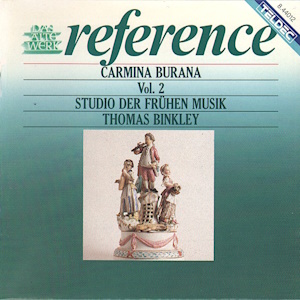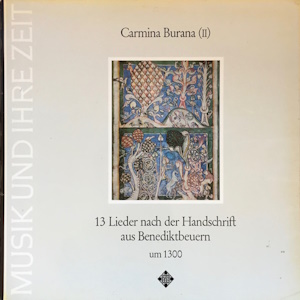 |
| 1 CD -
8.44012 ZS - (c) 1988 |
 |
1 LP -
SAWT 9522-A - (p) 1968
|
|
CARMINA BURANA (II) - 13 Lieder
nach der Handschrift aus Benediktbeurn
|
|
|
|
|
|
|
|
|
|
|
Homo quo vigeas,
C.B. No. 22 - Mezzosopran, 3 Tenöre,
Baß, Posaune
|
|
1' 22" |
1 |
A1
|
| Walther von Châtillon
|
Ecce torpet,
C.B. No. 3 - Baß, Organetto,
Fidel, Laute, Tambourin, Schellen |
|
6' 35" |
2 |
A2
|
|
Licet eger cum
egrotis, C.B. No. 8 - Tenor,
rebab |
|
4' 32" |
3 |
A3
|
Peter von Blois
|
Vite
perdite, C.B. No. 31 (Peter
von Blois) - Mezzosopran,
Countertenor, 3 Tenöre, Baß, Rebec,
2 Tambourins |
|
3' 35" |
4 |
A4
|
|
Crucifigat
omnes, C.B. No. 47 -
Mezzosopran, Countertenor, 3
Tenöre, Baß |
|
2' 55" |
5 |
A5
|
|
O varium
Fortuna, C.B. No. 14 -
Mezzosopran, Tenor |
|
4' 00" |
6 |
A6
|
|
Celum non animum,
C.B. No. 15 - Mezzosopran, 2 Tenöre |
|
4' 05" |
7 |
B1
|
| Peter von Blois |
Dum
iuventus, C.B. No. 30 (Peter
von Blois) - Tenor, Laute, Fidel
|
|
3' 10" |
8 |
B2 |
|
Axe
Phebus aureo, C.B. No. 71 -
Mezzosopran, Rebec, Laute |
|
2' 45" |
9 |
B3 |
|
Ecce
gratum, C.B. No. 143 - Tenor,
Laute, Fidel, Organetto, Schellen,
Tambourin |
|
2' 58" |
10 |
B4 |
|
Tellus flore,
C.B. No. 146 - Countertenor,
Citôle |
|
2' 25" |
11 |
B5 |
|
Tempus est
iocundum, C.B. No. 179 -
Mezzosopran, Rebec, Citôle |
|
3' 12" |
12 |
B6 |
Neidhardt von
Reuenthal
|
Nu gruonet aver
diu heide, C.B. No. 168a
(Neidhardt von Reuenthal) - Tenor,
Harfe, Psalterium, Rebab |
|
3' 28" |
13 |
B7 |
|
|
|
|
|
| STUDIO
DER FRÜHEN MUSIK |
Quellen:
|
-
Andrea von Ramm, Mezzosopran,
Harfe, Organetto
|
- Cambridge,
University Library Ff I-17
|
-
Willard Cobb, Tenor,
Tambourin
|
- Erfurt,
Staatsbibliothek Amplon. Oct. 32
|
-
Sterling Jones, Rebec,
Fidel, Rebab
|
- Florenz, Bibl.
Laurenziana, Pluteus 29. I. |
| -
Thomas Binkley, Posaune,
Laute, Tambourin, Citôle,
Psalterium |
- München, Bayr.
Staatsbibliothek, Codex Buranus
cm. 4660 (= Carmina Burana)
|
| Weitere
Mitwirkende: |
|
| -
Grayston Burgess, Countertenor |
|
| -
Nigel Rogers, Tenor,
Schellen, Tambourin |
|
-
Desmond Clayton, Tenor
|
|
| -
Jacques Villisech, Baß |
|
| -
Horst Huber, Schlaginstrumente |
|
| Thomas
BINKLEY, Übertragung und
Bearbeitung |
|
|
|
|
|
Luogo
e data di registrazione |
|
Amsterdam
(Holland) - Oktober 1967
|
|
|
Registrazione:
live / studio |
|
studio |
|
|
Producer |
|
Wolf
Erichson
|
|
|
Prima Edizione
LP |
|
Telefunken
- SAWT 9522-A - (1 LP) - durata
45' 23" - (p) 1968 - Analogico
|
|
|
Edizione
"Reference" CD
|
|
Tedec
- 8.44012 ZS - (1 CD) - LC 3706 -
durata 45' 23" - (c) 1988 - AAD |
|
|
Cover |
|
"Musizierende
Kinder", Porzellan. Modell von M.
V. Acier, Meißen, um 1770. Museum
für Kunst und Gewerbe, Hamburg.
|
|
|
|
|
Among the
most valuable treasures
of the Bavarian State
Library in Munich is
Codex latinus monacensis
4660, comprising the
most comprehensive and
most important
collection of secular
Latin lyrics of the
Middle Ages (often
erroneously generalized
under the expression
"Goliardic song"), the Carmina
Burana.
Before being moved to
the Royal Court and
Central Library during
the secularisation of
Bavarian Monasteries in
1803, the manuscript was
kept in the
Benediktbeuren
Monastery; hence this
collection of poetry was
named by its first
editor, the librarian
Johannes Andreas
Schmeller, "Songs from
Benediktbeuren".
When the manuscript was
written, after the
moddle of the 13th
century, somewhere in
South Germany (or
Tyrol?), the flowering
of secular Latin poetry
was already over. Thus
the collection is not a
textbook of a Goliard
but an anthology written
on the order probably of
a clerical aristocrat
who enjoyed this poetry.
The manuscript can be
compared in kind to the
large collections of
middle-high German
poetry such as the
Manesse manuscript.
The manuscript brings
together over 200 pieces
of differing content and
character. The order of
the pieces (disrupted
through binding) was
carefully planned
according to four main
groups: moral and
satirical songs
(observations and
laments on the course of
the world or the
lowering of morals, love
songs, drinking songs,
game songs and real
Goliardie poetry (no
neumes preserved), and
sacred plays. poems of
subjective sensitivity
are found sext to poems
of didactic or learned
character. The greatest
portion sterms from the
late 11th and the 12th
centuries; the majority
of the poetry originated
in France. a few German
poems are mixed in with
the Latin ones. As was
the custom in such
anthologies, the poets
were not named, almost
without exceptions;
however many poems are
lnown through other
soucers, and we can thus
recognize the work of
few known poets as
Walther de Chatillon,
Petrous de Blois, the
archipoeta, etc., while
other poems can be
arranged in groups. The
concordant sources of
single poems are
particularly important
for the reconstruction
of the original texts;
in codex Buranus the
texts are often corrupt.
It seems that the
inclusion of neumes had
been planned for much of
the manuscripts, but
this was carried out for
only a small part, and
there only afterwards
and rather incompletely.
F.
Brunhölzl
The production in 1965
of the recording Carmina
Burana aus der
Originalhandschrift
(Teldec SAWT 9455-A) was
the first attempt to
enter the distant realm
of medieval Latin lyrics
in their original
musical settings. The
recording was an
immediate success, and
was winning prizes. The
performance style
clearly shows the
influence of Spanish
arab culture on Western
musical practice. Now,
after three years of
further research and
publication, this
emphasis seems
completely confirmed.
The present recording
not only delves further
in that direction but
also calls attention to
another important and
neglected aspect of the
musical practice of
pre-Fourteenth century
Europe: the
non-homogeneity of
regional sayles. The
manuscript Carmina
Burana in an
excellent choice of
subject because it is a
collection of European
poetry predominantly in
Latin, collected long
after the poetry itself
had been disseminated
throughout Europe. This
repertory was indeed
international and
interregional, and yet
its performance was
bound to regional
performance styles. It
is important to state
that this repertory was
regional by intent,
except in rare cases
such as C.B. No. 47, but
was destined to become
international quite by
natural processes. Our
sources for concordances
with the Carmina
Burana manuscript
extend over several
countries, including
England, France,
Germany, Italy and
Spain. We must insist
that the performance
given a random selection
of this repertory in the
provincial Alpine
Monastery of
Benediktbeuren in the
Thirteenth century,
where the manuscript was
copied, differed very
considerably from a
performance of that same
sampling in Córdoba or
Sevilla, major cultural
centers in which a
Christian minority lived
and studied alongside
the Sepharic and
(dominant) arabic
civilizations. Thus a
monophonic sequence may
have had a ritual choral
performance tradition in
St. Gall, the monks
singing to themselves
about themselves near
the center of the
Christian sphere of
influence, whereas in
Badejoz it becomes a
solo song, carrying a
message to the insecure
far outpost of
Christianity, where ad
educated man still
practiced his vernacular
employing the Arabic
alphabet. To a large
extent, the
differentiated styles of
regional performance are
documented in musical
sources, by commentary
of travellers and by
theoreticians
(especially Juan Gill's
Ars musice
written in Zamora about
this time, 1254, of the
establishment at
Salamanca of the first
university chair in
music in all of Europe).
We see the regional
performance styles as a
product of the degree of
exotic influence in that
region. During the early
period, the major
cultural center was
Córdoba, later Paris.
Distance from these and
other centers determined
to a great extent the
influence of these
centers of serious art
of the regions. Thus the
style known as
"Provençal" was able to
remain intact, being the
node between the arabic
South and the French
North. England and
Germany retained a
relatively isolated
character, while Spain
and Italy underwent
nearly constant change
of cultural equilibrium.
The two major poles were
the traditional
inherited performance
styles indigenous to the
area and the imported
and superimposed Arabic
style either as it was
introduced before the
nineth century, or as it
developed in Europe
during the following
centuries. The classical
form of the late
Andalusian style is
contained in the concept
of the "nuba", in the
idea of a complete
performance with several
parts including an
instrumental
improvisation without
rhythm, followed
immediately by one with
rhythm, then the
introduction of song
(after the attention of
the audience has been
attracted), then a
change of rhuthm with
more instrumental music,
then song again, etc.,
until the conclusion
(Ecce gratum). Opposed
to this style was a more
direcs, less organized
song-cum-accompaniment
style of the Germanic
countries (Dum iuventus
floruit).
We have discussed the
transcriptions, the
instruments and the
accompaniments
elsewhere, and invite
the reader to consult
the following:
- Minnesang und
Spruchdichtung, SAWT
9487-A
- Weltliche Musik um
1300, SAWT 9504-A
- Carmina Burana (I),
SAWT 9455-A
Thomas
Binkley
|
|